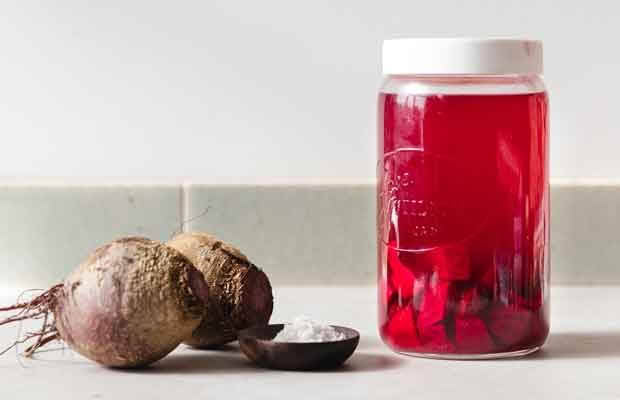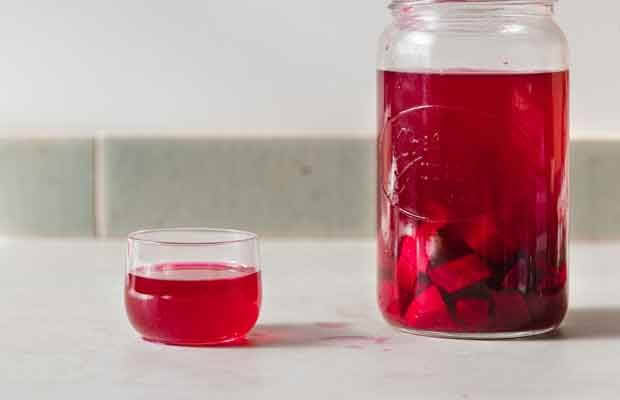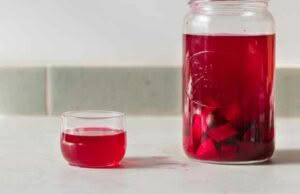Nicola Galloway: Time-honoured techniques and traditional beetroot Kvass

A simple and straightforward beetroot fermentation technique results in a digestive aid full of healthy bacteria
Words and Images: Nicola Galloway
For these blog entries, one of my focus areas is sharing recipes and preparation techniques that are a little different. Not necessarily your run-of-the-mill recipes, but ways of preparing food which might make us think outside the norm. It is a privilege to be able to learn new skills and I hope I might inspire you to try something different. I believe cooking is as much a way to nourish our bodies as our minds and soul.
These recipes and cooking techniques are not necessarily new, but ones that are part of my seasonal cooking rhythm. In the instance of fermentation that I share today, this has been an integral part of many traditional cuisines for hundreds, if not thousands of years. It was used as a way to preserve food before refrigeration, and in some cases to improve its digestibility (such as sourdough bread).
In the past, these recipes were handed down by the simple act of making them repeatedly. Most often from mothers and grandmothers to the next younger generation of daughters and granddaughters. After a few generations of a modern, fast-moving world, this passing of knowledge has been interrupted.
These traditional techniques are making a resurgence as we learn more about the benefits of fermented foods in our diet. Numerous books have been written on the subject and recipes abound online. Depending on the source these may not always be reliable so I recommend well-researched and documented books by those who literally ‘walk the talk’.
Some favourites include:
Wild Fermentation and The Art of Fermentation by Sandor Ellix Katz
Nourishing Traditions by Sally Fallon (this book was my introduction to fermentation)
Ferment For Good by Sharon Flynn.
Ferments certainly aren’t fast foods, they take time to prepare, and time to bubble and transform. But once ready they are quick to serve. As fermentation teacher Sharon Flynn (see book above) so perfectly puts it, these ancient foods are ‘the slowest kind of fast food’.

BEETROOT KVASS
I love beetroot, and it is one vegetable you always find in my fridge when it is available – which thankfully is most of the year. Roasted, grated, added to soups (see Beetroot Borscht), and it is even quite wonderful paired with chocolate in sweet recipes. Beetroot can also be used to make a simple fermented drink called kvass. A traditional preparation found in numerous variations across Eastern European countries.
Kvass is about as simple as it gets when it comes to home ferments. It doesn’t require a scoby like kombucha or kefir, however, you do need a culture to get things started. This can be the liquid from a previous ferment such as sauerkraut or lacto-fermented brine pickles. Or possibly easier to obtain if you are new to fermenting is cultured whey – the opaque liquid strained from yoghurt.
To procure whey, scoop ½ cup natural unsweetened yoghurt into a cheesecloth-lined sieve. Set over a bowl for several hours to collect the whey. The strained yoghurt, left long enough, will thicken into labneh – yoghurt cheese.
Beetroot kvass is a digestive aid full of healthy bacteria. Beetroot is a powerhouse of nutrients (maybe why I love it so much) which doubles down during fermentation to become a nourishing digestive tonic. As with any ferment, start small — about 50-80mls with breakfast is how I drink it.

Prep time: 15 minutes
Ferment time: 3-4 days
Makes about 750ml
INGREDIENTS:
1 medium beetroot (about 200g), washed and greens removed
2 tablespoons cultured whey (from yoghurt – see above) or liquid brine from sauerkraut
1 teaspoon sea salt
about 750ml cold filtered water
METHOD:
Peel the beetroot and roughly chop into 2cm chunks. Place in a clean 1 litre jar. Add the cultured whey/sauerkraut brine and salt. Fill up the jar with cold filtered, leaving a 1cm space on the top of the jar. Stir with a clean spoon and screw on the lid, or cover with cheesecloth secured with a rubber band.
Leave the jar on the kitchen bench for 3-4 days until small bubbles appear on the surface and the kvass smells mildly sour. Transfer the jar to the fridge – don’t strain it.
Drink 50-80 ml of the kvass daily, ideally with a meal.
Once the kvass is almost finished you can repeat this process with the same beetroot pieces. Leave about 2 tablespoons of the kvass in the jar, fill up with filtered water and add ½ teaspoon of salt. Stir well, cover, and leave on the bench for another 3-4 days until ready. Transfer to the fridge. This will be a weaker brew but still worth it to make the most of the beetroot.
Discard the beetroot once the second round of the kvass is finished. Start again with a new batch of beetroot.
Optional additions: if you like an extra flavourful drink and added goodness, add 2-3 crushed garlic cloves and/or 5-6 thin slices of fresh ginger root.
Nicola Galloway is an award-winning food writer, cookbook author and culinary tutor. Find more seasonal recipes on her website.

